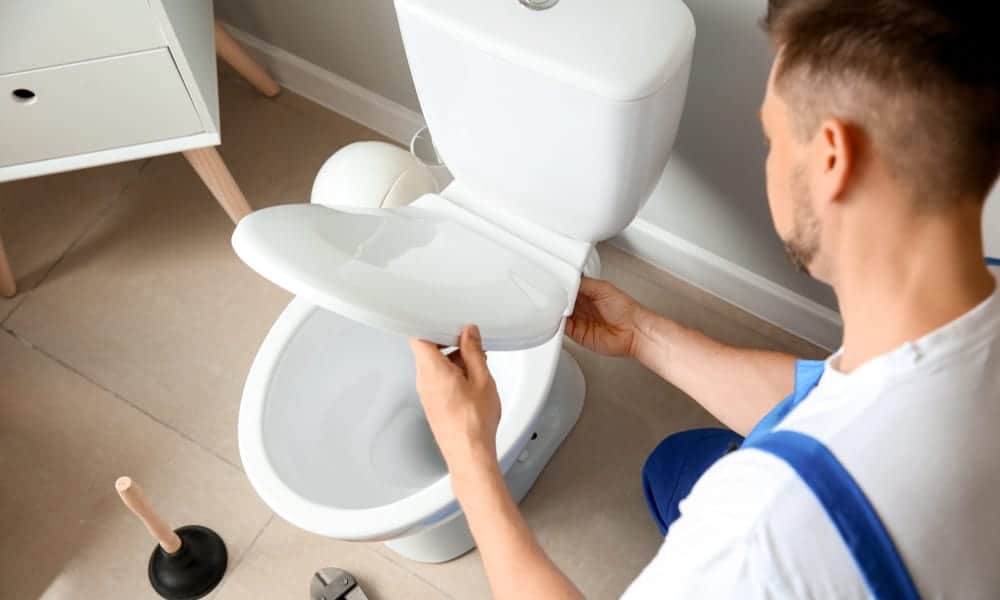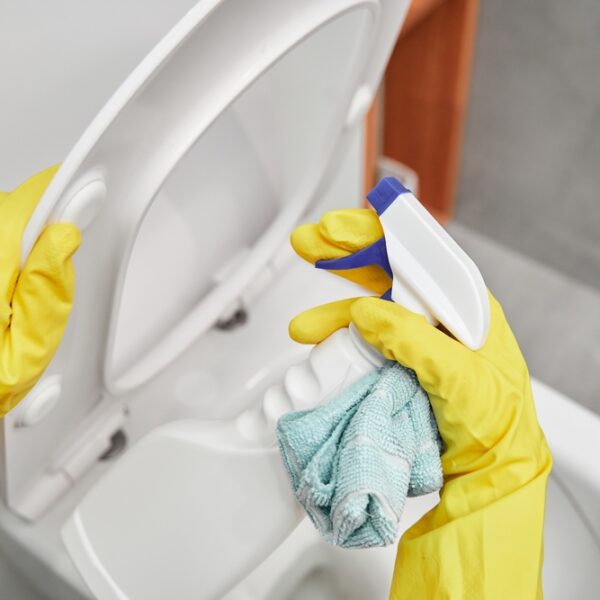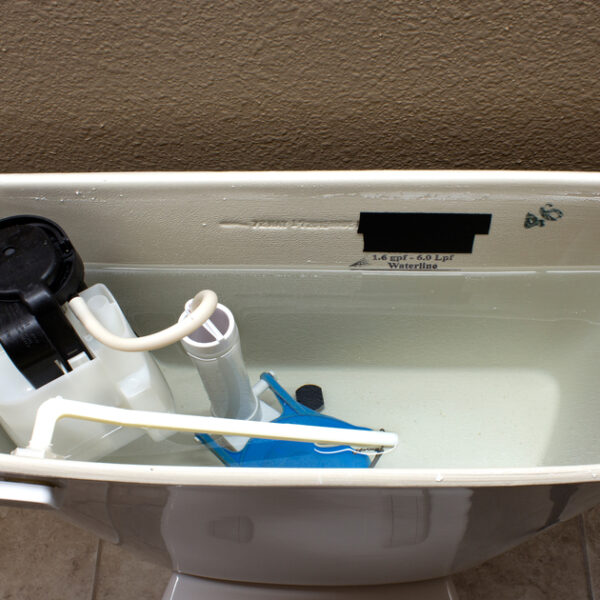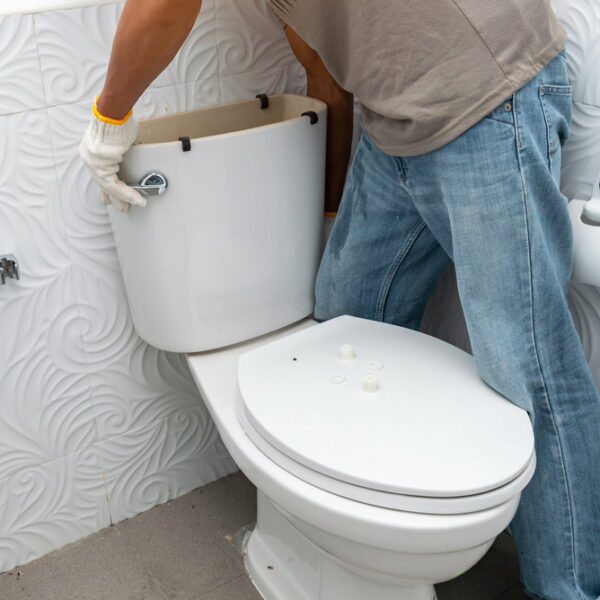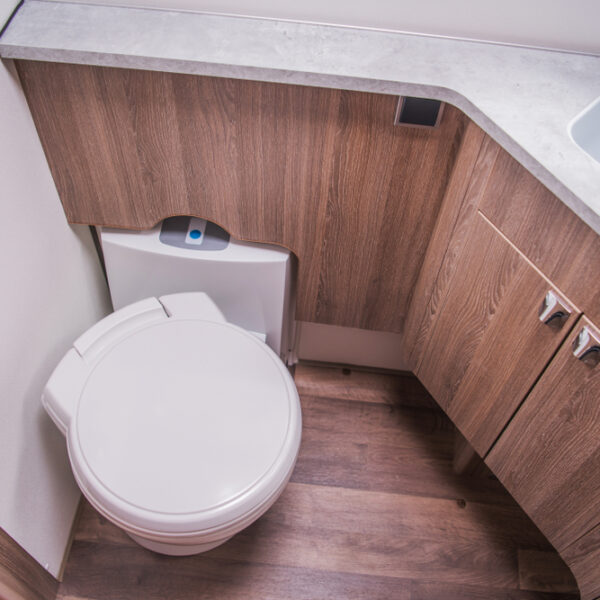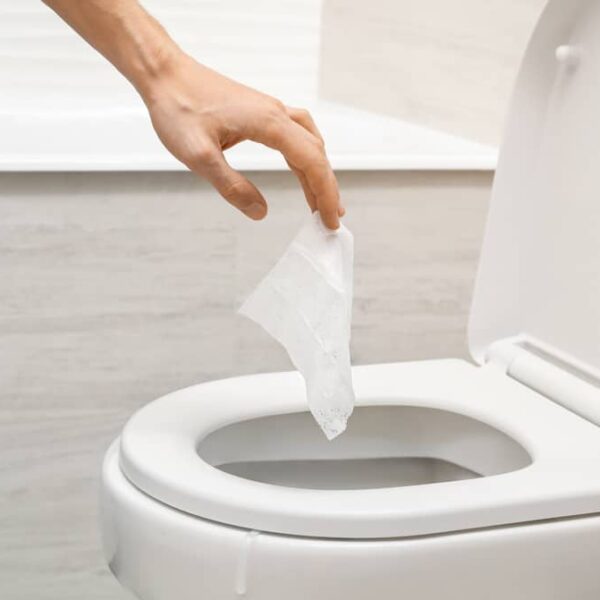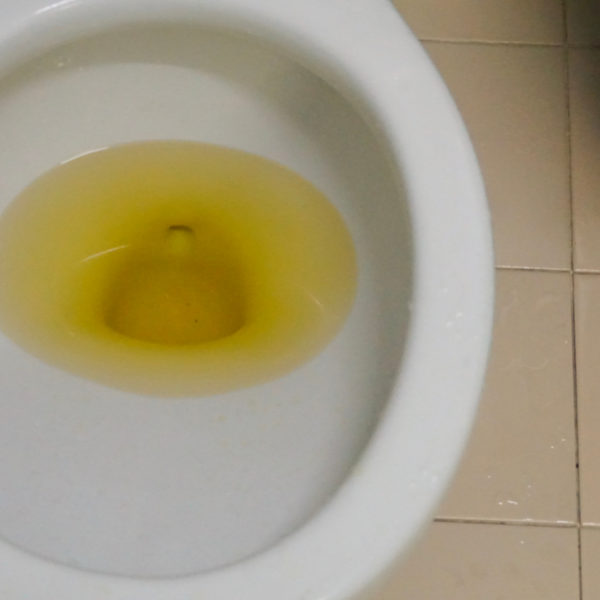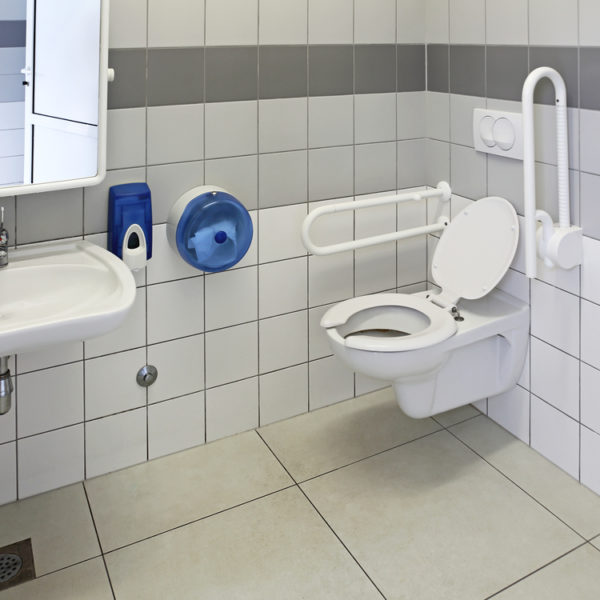Over time, everything wears out and needs replaced–your car, your clothes, your furniture, and even your toilet. While it may not be the most exciting thing to think about, replacing your toilet is a necessary evil that all homeowners have to face at some point. But how much does a plumber charge to replace a toilet?
The answer, unfortunately, is not as simple as we would like. The cost of replacing your toilet depends on a variety of factors, such as the type of toilet you have, the age of your home, the tasks your plumber needs to perform, and whether or not you need to make any repairs to the bathroom before installing the new toilet.
To give you a better idea of how much it will cost to replace your toilet, with or without a plumber, we’ve tried to untangle this complicated matter. Read on to learn more.
6 Signs You Should Replace an Existing Toilet
No one wants to think about replacing their toilets. In fact, we seem to think that they’re part of the house and will last just as long! However, just like other household fixtures, they do eventually wear out and need to be swapped for something new.
There are a few telltale signs that indicate it’s time to say goodbye to your old toilet and install a new one.
Sign 1: Old Toilet
If your toilet is pretty old, it’s probably time for an upgrade. This is especially true if you want to save money and water, since older models just aren’t as efficient as new toilets on the market.
In 1994, the Energy Policy Act of 1992 became law, requiring a change in how many gallons toilets could expend per flush. To give you an idea of this change, toilets made before 1994 used 3.5 to 5 gallons per flush (GPF). Newer, more efficient toilets use only 1.6 GPF (and high-efficiency ones use only 1.28 or less!), which can definitely save you money on your water bill each month–especially if you have several people living in your home!
Sign 2: Cracks or Leaks
Of course, if your toilet constantly leaks, it’s certainly time for a replacement. Not only is this wasteful, but it’s also costing you money on your water bill.
The way you know you have cracks or leaks in your toilet is pretty simple. One very apparent way is if puddles are forming on the floor around your toilet. Another slightly more subtle clue is if your toilet is always running. You’ll want to investigate that further to make sure it’s not a leak.
If you suspect a leak but can’t find one, just put a few drops of food coloring in the tank and see if it appears in the bowl or floor within several minutes. If it does, you have a problem that needs to be addressed ASAP!
Sign 3: Frequent Clogging
If your toilet is constantly getting clogged, it could be a sign that there’s something wrong. The original low-flow toilets weren’t very well designed and often resulted in more than one flush being required to get rid of solid waste. Replacing your toilet may help, as low-flow toilets are created much better these days.
Sign 4: Numerous Repairs
Another common issue that indicates it’s time for a new toilet is when you have numerous repairs.
You may have to jiggle the handle or hold it down for an unusually long time in order for your toilet to flush. You may have a broken flapper or fill valve or a leaky flush valve. Over time, several of these components can break down and need to be replaced–and sometimes it’s just easier to replace the whole toilet for one that is more convenient!
How Much Does It Cost to Replace a Toilet?
While these are all signs that it might be time to replace your toilet, there are other factors to consider as well. One important thing to think about is cost. How much does it cost to replace a toilet, and is it worth it?
The cost of replacing your toilet will vary depending on the type of toilet you have, the age and condition of your home and plumbing, and whether or not you need to make any repairs to the bathroom before installing the new toilet.
We’ve compiled a list of the factors that will affect the price: toilet type, age and condition of home and plumbing, and any bathroom repairs.
How Does the Type of Toilet Affect Price?
As you are likely aware, there are a few different types of toilets that you might have in your house. Each has a slightly different feel, look, and price. We will walk though the different toilet types to give you an idea of what you might be in the market for.
Two-Piece Toilets
The two-piece toilet is the most common type of toilet. It is composed of two separate pieces–the bowl and the tank.
Two-piece toilets can be either round or elongated. The elongated bowls are a bit longer, as the name suggests, and they tend to be more comfortable, while the round bowls take up less space.
There are different price tiers for each type of toilet, but on average, a round toilet will is usually a little bit less money than an elongated one, with a basic one running at about $280 and a basic elongated one running at around $290.
One-Piece Toilets
The one-piece toilet is a newer style of toilet where the bowl and tank are merged into a single unit. They are becoming increasingly popular because they are easier to clean and have a sleeker, more modern look.
They do, however, tend to be more expensive than two-piece toilets, with a basic model running at about $400 on average.
Dual Flush Toilets
A dual flush toilet are a newer, more efficient type of toilet. They have two buttons or levers–one for liquid waste and one for solid waste. This allows you to use less water when flushing, saving you money on your water bill.
They come in either one-piece or two-piece and either round or elongated. While they are indeed slick, a basic model might run at about the $200-$400 range.
Smart Toilets
Smart toilets are the newest type of toilet technology on the market! They come loaded with awesome features like a self-closing lid, a night light, seat warmers, and even a bidet seat or attachment, if desired.
While all of these bells and whistles might be enticing, they do come with a heftier price tag too, running at least a couple thousand dollars on average. Definitely expect to pay more for a smart toilet than a traditional one.
And, of course, there is the aspect of maintenance to keep in mind. A smart fixture with all its technology might require a little more care than a regular one. There are also more costly pieces that could wear out, which might only be able to be replaced by a professional.
How Does the Age and Condition of Home and Plumbing Affect Price?
Age and condition of home and plumbing will also affect how much it costs to replace your toilet.
Building Code Standards
For example, if you have an older home, even in the 1990s or earlier, your bathroom might not be up to current building code standards.
The way you would check this is to have an inspection by a professional plumber. If your home is not up to code, then it might be wise to do some work to get it there before you install a new toilet. It will cost more in the short run, but could save you a lot of money and hassle down the road.
Pipe Configuration
Another thing to keep in mind is the configuration of your pipes.
Older homes tend to have a 10-inch rough-in, which is the piping behind the toilet, connecting it to the pipes in the wall. The modern configuration tends to be a 12-inch rough-in.
Because of their designs, a toilet with a 10-inch rough-in will fit within a 12-inch rough-in space, but this will not work the other way around.
Plus, it’s getting more and more difficult to find toilets that are built for a 10-inch rough-in space. Not to mention, they tend to run more expensive than the 12-inch rough-in.
This is definitely something to consider if you have a 10-inch rough-in space in your bathroom.
Toilet Location
The location of your toilet can also affect price. If your toilet is located in a difficult-to-reach spot, like in a tight space or on an upper floor, then it might cost a bit more to replace because the plumber will need to take extra care in removing and installing the new toilet.
How Do Bathroom Repairs Affect Price?
Sometimes the bathroom itself needs some renovating before you can replace your toilet. This can happen especially when the toilet has caused major problems.
With the toilet uninstalled and out of the way, this is the perfect time to tackle those projects. Waiting until you’ve installed the new toilet would just cause more issues later.
If you find yourself in a place where bathroom renovations need to be made, there will most definitely be additional costs involved in your toilet replacement project–mainly in labor and materials.
Here are some common issues people face when they need to renovate their bathroom:
Sagging the Floor
If you have unexpected leaks in your toilet’s wax ring seal or a cracked flange, this can affect the subfloor beneath your bathroom toilet. Water will cause the subflooring to sag and rot. When this happens, the damage needs to be addressed before you install a new toilet.
To fix the subfloor beneath a toilet, you will very likely need to hire a contractor and plumber to help you. You will also need to purchase replacement materials such as subflooring and tile or linoleum for the bathroom floor. Costs like these will run the whole gamut.
Mold and Mildew
Mold and mildew can develop in bathrooms because of the moisture that’s produced when showers are taken, toilets flushed, and sinks used.
Mold and mildew are dangerous because they can cause respiratory problems. They can also spread quickly if not taken care of right away.
If you have mold or mildew in your bathroom, it needs to be removed before you replace the toilet. This is something you might be able to do yourself with some cleaning supplies, but depending on the severity, you might need to call in a professional.
Again, this is something that needs to be addressed before you install your new toilet.
How Much Does A Plumber Charge To Replace a Toilet?
When you replace your toilet, the actual toilet is only a small part of the overall cost. The other costs come from the materials needed to install the new toilet and the labor involved in doing toilet removal and installment.
On average, expect to pay between $200 and $500 to replace your toilet if it is one of your basic, average models. The labor costs of hiring a plumber is quite a wide range, but an average cost is between $75-$200. Please note that the toilet installation costs may also include a service charge fee, so asking for an estimate ahead of time may be your wisest bet.
If you do need to hire a plumber, make sure he or she is licensed and insured–or you might be paying for the toilet replacement long after the plumber has moved on.
Steps to Replace a Toilet On Your Own (DIY)
In order to save money and avoid toilet replacement costs, you may decide to replace your toilet on your own.
However, it’s important to note that installing a toilet is not a simple DIY project for everyone. It’s an intermediate level job, and could take around 1-4 hours to complete (or more) depending on the severity of the problem and your skill level.
But if you’re feeling up to the challenge, there are some basic steps you’ll need to take to replace your toilet.
Materials You Might Need:
- a new toilet
- a replacement flange (if needed)
- a screwdriver or drill
- a wrench and nuts
- a hacksaw
- a new toilet wax ring seal
- a tube of acrylic caulk
- a new wax ring
- a damp sponge
Step 1: Remove the Old Toilet
First, turn off the water to the toilet. Then, flush the toilet to empty the tank. Next, unhook the toilet from the water supply in the wall, unscrew the bolts that hold the tank to the bowl, and lift it off. Finally, remove the bolts that hold the bowl to the floor and lift it off.
Step 2: Install the New Bowl
Start by inspecting to see if you need a new flange. If so, purchase one and screw it down. Place a new wax ring seal on the flange. Then, set the new bowl in place overtop the wax ring seal.
Be careful to bear weight straight down on the wax, as jostling back and forth will weaken the watertight seal. Screw the toilet bowl into the floor and saw off the screws with a hacksaw if they are too long.
Step 3: Install the New Tank
Install the gasket that attaches the tank to the bowl at the base of the flush valve. Then attach the new tank to the bowl using the supplied bolts and washers.
Then, reconnect the water supply line from the wall to the tank. Finally, turn on the water and flush the toilet to test for leaks.
Step 4: Caulk Around the Toilet Base
Use a tube of silicone or acrylic caulk to make a watertight seal around the base of the toilet.
Tip: Leave about six inches at the back of the toilet uncaulked in order to allow water to escape in case there is an internal leak down the road.
Caulking the toilet base will provide aesthetic appeal as well as prevent water and urine from seeping into the floor.
Now You Know How to Replace Your Toilet
Replacing a toilet is a little more complicated than you might originally think. It really depends on the type of toilet you purchase, the condition of your home and plumbing, and how much a plumber will charge for installation.
You can save money by doing it yourself, but it’s important to note that installing a toilet is not a simple DIY project. If you’re not experienced in plumbing, it’s best to leave it to the professionals.
How confident are you in replacing your own toilet, or do you think it’s a job you’d hire out for? Let us know in the comments below!
